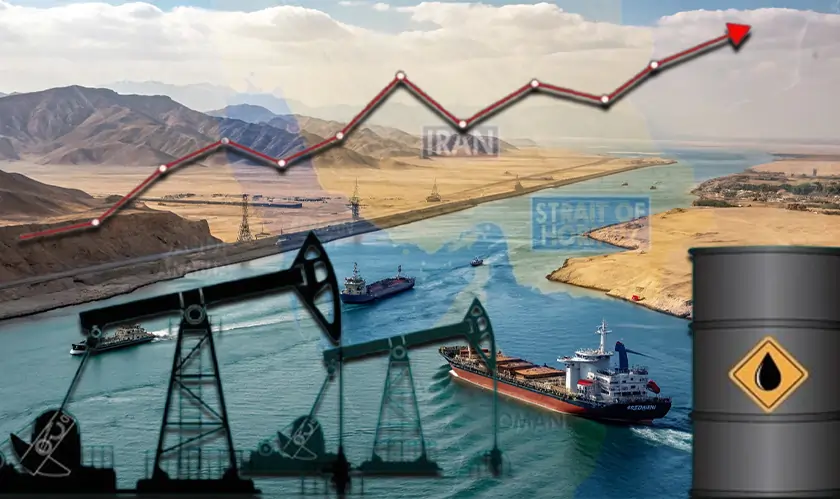Home Industry Oil and gas The Strait of Hormuz: Why This...
Oil And Gas

CIO Bulletin
23 June, 2025
Envision a narrow stretch of water, just about 33 kilometers wide at its tightest point, acts as the lifeblood of the global economy. Yes, this is the Strait of Hormuz, a critical chokepoint that connects the Persian Gulf to the world’s oceans. Through its slender and slim shipping lanes—only 3 kilometers wide—flows more than a fifth of the planet’s oil supply, which powers major industries and economies worldwide. But recent tensions between Israel and Iran, including Iran’s reported parliamentary approval to close this vital route, have thrust the strait into the global spotlight, raising fears of surge in the oil prices and economic chaos. So, what makes this waterway so critical, and why does its potential closure matter to everyone? Let’s dive into the story of the Strait of Hormuz and explore its massive impact on global trade.
What Is the Strait of Hormuz?
Nestled between Iran to the north and Oman to the south, the Strait of Hormuz is a slender gateway that links the Persian Gulf with the Gulf of Oman and the Arabian Sea beyond. It acts as a bustling highway for humungous oil tankers, clasping through a narrow passage to deliver energy to the world. Despite its width, this strait is one of the most tactically important waterways on Earth, often called the “world’s most critical oil chokepoint.”
The strait’s significance lies in its role as a channel for energy. Every day, large supertankers carry between 17.8 and 20.8 million barrels of crude oil, condensate, and fuels through its waters. That’s roughly one-fifth of global oil consumption, powering economies from Asia to Europe. Qatar, a leading exporter of liquefied natural gas (LNG), also relies heavily on the strait to ship its energy supplies. Simply put, the Strait of Hormuz is the heart of global energy trade.
Why Does the Strait Matter to Global Trade?
The Strait of Hormuz isn’t just a waterway—it’s a pivotal link for the global economy. Major oil-producing nations like Saudi Arabia, Iran, the United Arab Emirates, Kuwait, and Iraq, all members of the Organization of the Petroleum Exporting Countries (OPEC), depend on the strait to export their crude, primarily to energy-hungry markets in Asia. For countries like China, which buys nearly 90% of Iran’s oil exports, the strait is critical to keeping industries running and lights on.
But it’s not just oil. The strait also carries vast amounts of LNG, chemicals, and other goods, making it a cornerstone of global supply chains. The U.S. Fifth Fleet, stationed in Bahrain, patrols these waters to ensure safe passage for commercial ships, underscoring the strait’s geopolitical importance. Any disruption here could send shockwaves through markets, spike energy prices, and trigger inflation worldwide.
A Chokepoint with Global Consequences
What happens if the Strait of Hormuz closes? The fallout would be immediate and far-reaching. A closure would halt the flow of millions of barrels of oil daily, causing a sharp spike in global oil prices. For the United States, this could mean higher gas prices and inflation, hitting consumers and businesses hard. In Europe, energy costs could soar, straining economies already coping with volatility. In Asia, particularly in China, a disruption could cripple industries reliant on Middle Eastern oil, slowing economic growth.
Yet, closing the strait would also hurt Iran itself. As an oil exporter, Iran relies on the same waterway to ship its crude. A closure could alienate allies like China and provoke Gulf Arab states, such as Saudi Arabia and the UAE, who also depend on the strait for their exports. It’s a high-stakes move that analysts describe as “economic suicide” for Iran, but one that could be used as power in times of conflict.
Iran’s Threat to Close the Strait: What’s Happening Now?
Recent events have brought the Strait of Hormuz back into focus. Following reported U.S. military strikes on Iranian nuclear sites in June 2025, Iran’s parliament reportedly approved a measure to close the strait, according to Iranian state media. While the final decision rests with Iran’s top security leaders, the threat alone has rattled global markets. Iran’s foreign minister, Seyed Abbas Araghchi, warned of “everlasting consequences” for the U.S. actions, while Supreme Leader Ayatollah Ali Khamenei vowed punishment for Israel, a U.S. ally in the strikes.
This isn’t the first time Iran has threatened to block the strait. During the 2012 sanctions standoff with the U.S. and Europe, Iran hinted at closure but never followed through. In 2019, attacks on oil tankers near the strait raised fears of escalation, and in recent years, Iran has seized several vessels in the region. Each incident underscores the strait’s vulnerability and its role as a flashpoint in geopolitical tensions.
Why Would Iran Consider Such a Drastic Step?
Closing the Strait of Hormuz would be a bold, retaliatory move against perceived aggression, particularly from the U.S. and Israel. By blocking off global oil supplies, Iran could impose economic pain on its adversaries, driving up energy costs and stoking inflation. The move would also signal Iran’s willingness to escalate conflicts, putting pressure on world powers to negotiate or back down.
However, the risks are enormous. A closure could unite Gulf Arab states against Iran, draw in global powers like the U.S. and China, and devastate Iran’s own economy. U.S. Secretary of State Marco Rubio has urged China to intervene, noting Beijing’s heavy reliance on the strait for oil imports. The delicate balance of power in the region makes the strait a dangerous bargaining chip.
A History of Tensions in the Strait
The Strait of Hormuz has long been a hotspot for conflict. During the 1980–1988 Iran-Iraq War, both sides targeted each other’s oil exports in the “Tanker War,” disrupting global trade. In 1988, a U.S. warship mistakenly shot down an Iranian airliner, killing 290 people, further straining relations. More recently, in 2019, attacks on Saudi oil tankers near the strait heightened fears of a wider conflict.
These incidents highlight the strait’s role as a geopolitical pressure point. With the U.S. now a major oil exporter, its reliance on the strait has decreased, but its commitment to protecting global trade routes remains strong. Meanwhile, Asia’s growing demand for Middle Eastern oil has made the strait even more critical to the global economy.
Could the Strait Be Bypassed?
Some Gulf states have explored alternatives to reduce their dependence on the Strait of Hormuz. Saudi Arabia and the UAE have pipelines that can carry about 2.6 million barrels of oil per day, bypassing the strait, according to the U.S. Energy Information Administration. However, this capacity is a fraction of the 20 million barrels that flow through the strait daily. For LNG exporters like Qatar, there are no viable alternative routes, making the strait indispensable.
What’s Next for the Strait of Hormuz?
As tensions simmer in the Middle East, the world watches the Strait of Hormuz closely. Will Iran follow through on its threat to close this vital waterway, or is it a strategic bluff to gain control? The stakes couldn’t be higher. A closure would disrupt global trade, spike energy prices, and risk a wider conflict involving major powers. Even the threat of closure has already prompted some supertankers to reroute, a sign of the uncertainty gripping the region.
For now, the U.S. Fifth Fleet continues its patrols, and diplomats urge restraint. But the Strait of Hormuz remains a fragile link in the global economy, where a single spark could ignite far-reaching consequences. As consumers, businesses, and governments brace for potential disruptions, one thing is clear: this narrow waterway holds the power to shape the world’s economic future.
FAQs
Mostbet, yeni üyelerine hoş geldin bonuslarıyla avantajlı bir başlangıç fırsatı sunar.
Промокоды 1Win увеличивают ваши шансы на победу.
Kasyno online to nie tylko gry, ale także społeczność graczy, którzy dzielą się swoimi doświadczeniami!







